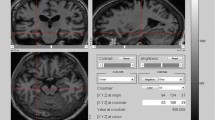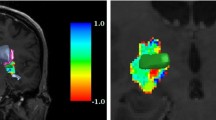Abstract
Purpose
Deep brain stimulation (DBS) is a surgical procedure for treating motor-related neurological disorders. DBS clinical efficacy hinges on precise surgical planning and accurate electrode placement, which in turn call upon several image processing and visualization tasks, such as image registration, image segmentation, image fusion, and 3D visualization. These tasks are often performed by a heterogeneous set of software tools, which adopt differing formats and geometrical conventions and require patient-specific parameterization or interactive tuning. To overcome these issues, we introduce in this article PyDBS, a fully integrated and automated image processing workflow for DBS surgery.
Methods
PyDBS consists of three image processing pipelines and three visualization modules assisting clinicians through the entire DBS surgical workflow, from the preoperative planning of electrode trajectories to the postoperative assessment of electrode placement. The system’s robustness, speed, and accuracy were assessed by means of a retrospective validation, based on 92 clinical cases.
Results
The complete PyDBS workflow achieved satisfactory results in 92 % of tested cases, with a median processing time of 28 min per patient.
Conclusion
The results obtained are compatible with the adoption of PyDBS in clinical practice.










Similar content being viewed by others
References
Tisch S, Zrinzo L, Limousin P, Bhatia KP, Quinn N, Ashkan K, Hariz M (2007) Effect of electrode contact location on clinical efficacy of pallidal deep brain stimulation in primary generalised dystonia. J Neurol Neurosurg Psychiatry 78(12):1314–1319
York MK, Wilde EA, Simpson R, Jankovic J (2009) Relationship between neuropsychological outcome and dbs surgical trajectory and electrode location. J Neurol Sci 287(1):159–171
Lalys F, Haegelen C, Mehri M, Drapier S, Verin M, Jannin P (2013) Anatomo-clinical atlases correlate clinical data and electrode contact coordinates: application to subthalamic deep brain stimulation. J Neurosci Methods 212(2):297–307
Dormont D, Seidenwurm D, Galanaud D, Cornu P, Yelnik J, Bardinet E (2010) Neuroimaging and deep brain stimulation. AJNR Am J Neuroradiol 31(1):15–23
Guo T, Finnis KW, Parrent AG, Peters TM (2006) Visualization and navigation system development and application for stereotactic deep-brain neurosurgeries. Comput Aided Surg 11(5):231–239
Miocinovic S, Noecker A, Maks C, Butson C, McIntyre CC (2007) Operative neuromodulation., Cicerone: stereotactic neurophysiological recording and deep brain stimulation electrode placement software systemSpringer, Berlin
DHaese PF, Pallavaram S, Li R, Remple MS, Kao C, Neimat JS, Konrad PE, Dawant BM (2012) Cranialvault and its crave tools: a clinical computer assistance system for deep brain stimulation (DBS) therapy. Med Image Anal 16(3):744–753
Pallavaram S, Phibbs FT, Tolleson C, Davis TL, Fang J, Hedera P, Li R, Koyama T, Dawant BM, D’Haese PF (2013) Neurologist consistency in interpreting information provided by an interactive visualization software for deep brain stimulation postoperative programming assistance. Neuromodulation: Technology at the Neural. Interface 17:11–15
Fedorov A, Beichel R, Kalpathy-Cramer J, Finet J, Fillion-Robin JC, Pujol S et al (2012) 3D Slicer as an image computing platform for the Quantitative Imaging Network. Magn Reson Imaging 30(9):1323–1341
3D Slicer. http://www.slicer.org. Accessed 2013-04-05
Zrinzo L, van Hulzen AL, Gorgulho AA, Limousin P, Staal MJ, De Salles AA, Hariz MI (2009) Avoiding the ventricle: a simple step to improve accuracy of anatomical targeting during deep brain stimulation: clinical article. J Neurosurg 110(6):1283–1290
Neuroimaging Informatics Technology Initiative. http://nifti.nimh.nih.gov. Accessed 2013-04-05
Rivière D, Régis J, Cointepas Y, Papadopoulos-Orfanos D, Cachia A, Mangin J (2003) A freely available anatomist/brainvisa package for structural morphometry of the cortical sulci. Neuroimage 19(2 part 2):19–22
BrainVISA Morphologist. http://brainvisa.info. Accessed 2013-04-05
Pallavaram S, Yu H, Spooner J, DHaese PF, Bodenheimer B, Konrad PE, Dawant BM (2008) Intersurgeon variability in the selection of anterior and posterior commissures and its potential effects on target localization. Stereotact Funct Neurosurg 86(2):113–119
Jenkinson M, Smith S et al (2001) A global optimisation method for robust affine registration of brain images. Med Imag Anal 5(2):143–156
Jenkinson M, Bannister P, Brady M, Smith S et al (2002) Improved optimization for the robust and accurate linear registration and motion correction of brain images. Neuroimage 17(2):825–841
Haegelen C, Coupé P, Fonov V, Guizard N, Jannin P, Morandi X, Collins DL (2013) Automated segmentation of basal ganglia and deep brain structures in MRI of Parkinson’s disease. Int J Comput Assist Radiol Surg 8(1):99–110
Lalys F, Haegelen C, Abadie A, Jannin P, et al. (2009) Post-operative assessment in deep brain stimulation based on multimodal images: registration workflow and validation. In: Proceedings of SPIE, vol 7261, pp 72612M–1
Avants BB, Epstein CL, Grossman M, Gee JC (2008) Symmetric diffeomorphic image registration with cross-correlation: evaluating automated labeling of elderly and neurodegenerative brain. Med Imag Anal 12(1):26–41
Advanced Normalization ToolS. http://www.picsl.upenn.edu/ANTS. Accessed 2013-04-05
Klein A, Andersson J, Ardekani BA, Ashburner J, Avants B, Chiang MC, Christensen GE, Collins DL, Gee J, Hellier P et al (2009) Evaluation of nonlinear deformation algorithms applied to human brain MRI registration. Neuroimage 46(3):786
Arun KS, Huang TS, Blostein SD (1987) Least-squares fitting of two 3-d point sets. IEEE Trans Pattern Anal Mach Intell 9(5):698–700
Essert C, Haegelen C, Lalys F, Abadie A, Jannin P (2012) Automatic computation of electrode trajectories for deep brain stimulation: a hybrid symbolic and numerical approach. Int J Comput Assist Radiol Surg 7(4):517–532
Lalys F, Haegelen C, Dalbis T, Jannin P (2014) Analysis of electrode deformations in deep brain stimulation surgery. Int J Comput Assist Radiol Surg 9(1):107–117
Acknowledgments
The authors thank the French National Research Agency (ANR) who founded this work through the ACouStiC project grant (ANR 2010 BLAN 0209 01).
Conflict of interest
The authors declare that they have no conflict of interest.
Author information
Authors and Affiliations
Corresponding author
Rights and permissions
About this article
Cite this article
D’Albis, T., Haegelen, C., Essert, C. et al. PyDBS: an automated image processing workflow for deep brain stimulation surgery. Int J CARS 10, 117–128 (2015). https://doi.org/10.1007/s11548-014-1007-y
Received:
Accepted:
Published:
Issue Date:
DOI: https://doi.org/10.1007/s11548-014-1007-y




